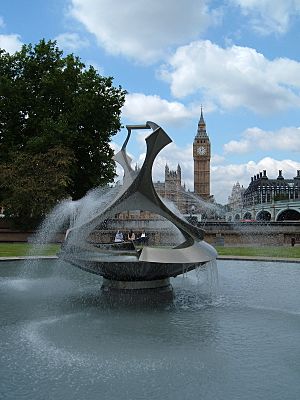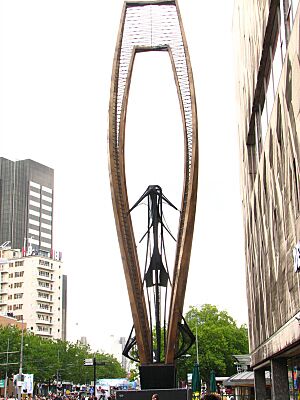Naum Gabo facts for kids
Quick facts for kids
Naum Gabo
|
|
|---|---|

Naum Gabo (1957)
|
|
| Born |
Naum Neemia Pevsner
5 August 1890 Bryansk, Oryol Governorate, Russian Empire
|
| Died | 23 August 1977 (aged 87) |
| Nationality | Russian |
| Known for | Sculpture, Kinetic art, Printmaking |
| Movement | Constructivism |
Naum Gabo, born Naum Neemia Pevsner (5 August 1890 – 23 August 1977), was a very important sculptor and thinker. He was a key artist in Russia after the Revolution. He also helped shape how sculpture developed in the 20th century.
Gabo's art mixed geometric abstraction (art made from simple shapes) with a lively way of organizing forms. He made small sculptures, huge public artworks, and was a pioneer in kinetic art. Kinetic art is art that moves. He used new materials like nylon, wire, clear plastic (lucite), glass, and metal. Gabo traveled a lot, living in Berlin, Paris, Oslo, Moscow, London, and finally the United States. He was part of major art movements like Cubism, Futurism, Constructivism, the Bauhaus, de Stijl, and Abstraction-Création.
Two special things Gabo focused on were showing "negative space" (the empty space around or within an object) and time. He explored negative space in his Linear Construction works (1942-1971). Here, he used nylon threads to create empty areas that felt as real as solid parts. He explored time in his famous Kinetic Sculpture (Standing Waves) (1920). This piece is often seen as the first kinetic artwork ever.
Gabo shared many of his ideas in the Constructivist Realistic Manifesto. He published this with his brother, sculptor Antoine Pevsner, in 1920. They handed it out at their outdoor art show in Moscow. In it, Gabo wanted to move beyond Cubism and Futurism. He felt these styles used color, lines, and shapes in a way that was too still or just for decoration. Instead, he wanted to use "kinetic rhythms," which he saw as the basic ways we understand real time. Gabo believed that sculpture, especially abstract Constructivist sculpture, could show human feelings and spirituality. He thought it could connect with modern life, social progress, and new science and technology.
After working on smaller pieces in England during World War II (1936-1946), Gabo moved to the United States. There, he received several requests for large public sculptures. Some of these he finished, like Constructie, an 81-foot monument in front of the Bijenkorf Department Store in Rotterdam (1954, unveiled 1957). Another was Revolving Torsion, a large fountain outside St Thomas Hospital in London. The Tate Gallery in London held a big show of Gabo's work in 1966. They, along with the Museum of Modern Art and Guggenheim Museum in New York, have many of his important pieces. Gabo's art can also be found at Rockefeller Center in New York City and The Governor Nelson A. Rockefeller Empire State Plaza Art Collection in Albany, NY.
Contents
Early Life and Learning
Gabo grew up in a Jewish family with six children in Bryansk, a town in Russia. His father, Boris Pevsner, was an engineer. His older brother, Antoine Pevsner, was also a famous Constructivist artist. Gabo changed his name so people wouldn't confuse him with his brother.
Gabo could speak and write German, French, and English very well, besides his native Russian. Being able to speak many languages helped him travel and work in different countries throughout his career. He once said, "Just like in thinking, in feeling, a vague message is no message at all."
After finishing school in Kursk, Gabo went to Munich University in 1910. He first studied medicine, then natural sciences. He also went to art history lectures by Heinrich Wölfflin. In 1912, Gabo moved to an engineering school in Munich. There, he discovered abstract art and met Wassily Kandinsky. In 1913-1914, he joined his brother Antoine in Paris, who was already a known painter. Gabo's engineering training was very important for his sculptures, which often used parts that looked like they were made by machines.
Exploring Constructivism
When World War I started, Gabo moved to Copenhagen and then Oslo with his older brother Alexei. He made his first sculptures under the name Naum Gabo in 1915. These early works, made from cardboard or wood, were often figures, like Head No.2 in the Tate collection. In 1917, he moved back to Russia to get involved in art and politics. He spent five years in Moscow with his brother Antoine.
Gabo helped with outdoor art shows that spread political messages. He also taught at 'VKhUTEMAS', a famous art and technical school. He taught alongside artists like Tatlin, Kandinsky, and Rodchenko. During this time, his sculptures became more geometric. Gabo also started trying out kinetic sculpture (moving art), but most of these early works were lost. Gabo's ideas for sculptures became very large, but it was hard to build them. He said, "It was the height of civil war, hunger and disorder in Russia. To find any part of machinery … was next to impossible."
In August 1920, Gabo and Antoine Pevsner wrote and published the "Realistic Manifesto". This paper explained the main ideas of pure Constructivism, and it was the first time the word "Constructivism" was used. In the manifesto, Gabo said that Cubism and Futurism were not fully abstract arts. He believed that spiritual experience was the true source of art. Gabo and Pevsner shared their manifesto by holding an exhibition on a bandstand in Moscow and putting copies on billboards around the city.
In Germany, Gabo met artists from the de Stijl group and taught at the Bauhaus in 1928. During this time, he designed a fountain for Dresden, which was later destroyed. Gabo and Antoine Pevsner had a joint art show at the Galerie Percier in Paris in 1924. They also designed the sets and costumes for Diaghilev's ballet La Chatte (1926), which was shown in Paris and London. To escape the rise of the Nazis in Germany, the brothers stayed in Paris from 1932 to 1935. They were part of the Abstraction-Creation art group with Piet Mondrian.
Gabo visited London in 1935 and moved there in 1936. He felt that people there were hopeful and understood his abstract art. When World War II began, he followed his friends Barbara Hepworth and Ben Nicholson to St Ives in Cornwall. He first stayed with art critic Adrian Stokes and his wife Margaret Mellis. While in Cornwall, he kept working, though on a smaller scale. His ideas were important for the development of modern art in St Ives. You can see his influence in the paintings and sculptures of John Wells and Peter Lanyon. They created a softer, more natural form of Constructivism.
In 1946, Gabo, his wife, and daughter moved to the United States. They lived first in Woodbury, then in Middlebury, Connecticut. Naum Gabo passed away in Waterbury, Connecticut, in 1977.
Gabo's Big Ideas About Art
The main idea behind Gabo's art was exploring space. He believed he could show space without needing to show solid mass. His earliest sculptures, like Head No.2, were experiments in showing the volume of a shape without it being heavy. Gabo also believed, as he wrote in the Realistic Manifesto, that art needed to exist actively in four dimensions, including time.
Gabo spent his early years in Munich, where he was inspired by the art, science, and philosophy discussions of the early 20th century. Because of his involvement in these discussions, Gabo became a leading figure in Moscow’s avant-garde (new and experimental art) after the Russian Revolution. In Munich, Gabo attended lectures by art historian Heinrich Wölfflin. He also learned about the ideas of Albert Einstein and other new scientific thinkers, as well as the philosopher Henri Bergson. As a student of medicine, natural science, and engineering, he understood the order in nature. He felt this order connected all creation in the universe. Just before World War I in 1914, Gabo discovered contemporary art by reading Kandinsky’s Concerning the Spiritual in Art. This book explained the ideas of abstract art.
Gabo’s artistic vision was full of imagination and passion. His art shows have always created great excitement because of the strong feelings his sculptures bring out. Gabo said he was "making images to communicate my feelings of the world." In his work, Gabo used time and space as building blocks. In his art, solid material unfolds and becomes beautifully surreal and dreamlike. His sculptures connect what is real and touchable with what is not, and what is simple with endless imaginative possibilities.
Even though Gabo was very imaginative, he was also practical in how he created his works. He developed building systems that were used for his beautiful sculptures and could also be used for architecture. He was also creative with his materials. He used many different things, including early plastics, fishing line, bronze, sheets of clear plastic (Perspex), and even large rocks. Sometimes he even used motors to make his sculptures move.
Caroline Collier, an expert on Gabo’s work, said, "The real stuff of Gabo’s art is not his physical materials, but his perception of space, time and movement. In the calmness at the ‘still centre’ of even his smallest works, we sense the vastness of space, the enormity of his conception, time as continuous growth." The movement in Gabo’s sculptures is linked to a strong rhythm, which is deeper than the busy patterns of everyday life. The exact shapes of his art make you imagine traveling into, through, over, and around his sculptures.
Gabo wrote his Realistic Manifesto to explain his ideas for constructive art. He also shared his joy about the opportunities created by the Russian Revolution. Gabo saw the Revolution as a chance for people to renew their values. Five thousand copies of the manifesto were put up in Moscow streets in 1920.
Gabo lived through a revolution and two world wars. He was also Jewish and had to escape Nazi Germany. Gabo was very aware of the world's troubles. He found peace in the calm, perfect art forms he created. In his sculptures, he escaped all the chaos, violence, and sadness he had experienced. Gabo chose to look past the dark parts of his life. He created sculptures that, though they look fragile, are so balanced that they make us feel like they are gently holding back the world's problems.
Printmaking
Gabo started making prints in 1950. He was encouraged by William Ivins, a former curator of prints at the Metropolitan Museum of Modern Art in New York. His first print was a wood engraving made from a piece of furniture and printed on toilet paper. He went on to create many important and varied graphic works, including more complex and beautiful pieces, until he died in 1977.
Gabo did not like the traditional idea that prints should be made in many identical copies. Instead, he preferred to use the monoprint format. A monoprint is a unique print, and he used it as a way to experiment with his art.
Writings
- Of Divers Arts (1962). New York: Faber and Faber. ISBN: 978-0-571-05231-8
See also
 In Spanish: Naum Gabo para niños
In Spanish: Naum Gabo para niños



